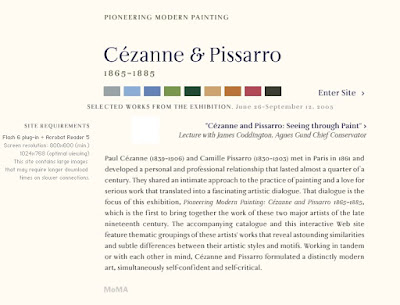Such different approaches to the same scene ... Cezanne left, Pissarro right.
Perhaps by necessity, they were rebels, bohemians, outsiders both, intent on shattering prevailing ideas about painting and about beauty. Newly arrived in Paris at the age of 22, Cezanne played the provocateur, flaunting his outsider, country-bumpkin status like a hipster in flannel and a lumberjack beard (or, as an astute New York Times reviewer of the show lovingly described him, "a furious misfit with the face of a hobbit, the mind of a scholar, and the mouth of a (dockworker).". He'd been packed off to Paris to study law, but instead he enrolled in painting classes at a walk-in art school.
Cezanne, left, Pissarro right, same delft vase.
Jacob Abraham Camille Pissarro was a Dutch citizen, a Jew born in the West Indies, who grew up learning French in an all-black school; he was shunned by the local rabbi because his father'd come to the island to deal with the estate of a deceased uncle and ended up staying and marrying the man's creole widow (his niece by marriage). Pissarro was one of the few artists or students in Paris who didn't either avoid, disparage, or make fun of Cezanne, so friends and allies they became.
Cezanne (l.), Pissarro (r.)
Pissarro was nine years older than Cezanne, a restless innovator with a single-minded drive to redefine painting that would eventually allow scholars to recognize him as the "pivotal" figure in avant-garde painting of the time. He sought out radical teachers like Courbet, settling eventually on Corot, but soon outgrew the soft focus approach with work that had the plein-air plainness of Daubigney - and "the future geometry of Mondrian" (Cotter).
Cezanne (l.), Pissarro (r.)
Pissarro afterward anchored and unified the young Impressionists, including Monet, Manet, Renoir, and Degas, and then pushed into the new territory of Post Impressionism, a father figure to Seurat, Cezanne, van Gogh, and Gaugin. Cezanne's work fits into the Modernist narrative as a turning away from Impressionism, but Cezanne was working it out with Pissarro as early as 1866 (the first Impressionist exhibition wasn't until 1874).
Again, same houses.
In Pontoise, the Paris suburb where Pissarro lived, the two painters often painting the same motif, sometimes in fundamentally different ways, a bit like Picasso and Braque, who together invented Cubism, picking up where the earlier odd couple left off ("My one and only master," Picasso called him, "Cezanne was like the father of us all").
Although the exhibition of 2006 has come been and gone, the Museum of Modern Art keeps a wonderful interactive catalogue parked on their website that's well worth poking around in. It's even got details of the brushwork of each painting. The article I cited above by Holland Cotter's great too.






